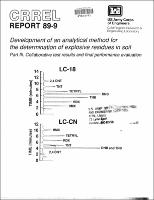Please use this identifier to cite or link to this item:
https://hdl.handle.net/11681/9125Full metadata record
| DC Field | Value | Language |
|---|---|---|
| dc.contributor | University of New Hampshire. Department of Chemistry | - |
| dc.contributor | U.S. Army Toxic and Hazardous Materials Agency | - |
| dc.contributor.author | Bauer, Christopher F. | - |
| dc.contributor.author | Koza, Stephan M. | - |
| dc.contributor.author | Jenkins, Thomas F. | - |
| dc.contributor.author | Schumacher, Patricia W. | - |
| dc.contributor.author | Miyares, Paul H. | - |
| dc.contributor.author | Walsh, Marianne E. | - |
| dc.date.accessioned | 2016-06-20T13:40:22Z | - |
| dc.date.available | 2016-06-20T13:40:22Z | - |
| dc.date.issued | 1989-05 | - |
| dc.identifier.uri | http://hdl.handle.net/11681/9125 | - |
| dc.description | CRREL Report | - |
| dc.description | Abstract: A collaborative test of a method for the determination of nitroaromatic and nitramine explosives in soil was conducted at eight laboratories. The method involves extraction of a 2.00-g portion of soil with 10.0 mL of acetonitrile in a sonic bath, dilution of 5.00 mL of soil extract with 5.00 mL of aqueous CaC12, filtration and determination by RP-HPLC-UV at 254 nm. Certified reporting limits (CRLs) and method detection limits (MDLs) were obtained for HMX, RDX, TNT and ten other analytes. Values ranged from 0.07 to 2.15 µg/g for the CRLs and from 0.03 to 1.27 µg/g for the MDLs. The collaborative test was conducted under the auspices of the Association of Official Analytical Chemists. The analytes (HMX, RDX, TNB, DNB, tetryl, TNT and 2,4-DNT) were measured in eight field-contaminated soils and eight spiked standard matrix soils. Both sets of eight consisted of four individual samples in duplicate. Concentrations ranged from the limits of detection to nearly 1000 µg/g. The results were evaluated by means of analysis of variance and regression analysis with and without the inclusion of data identified as outliers. When outliers were excluded, method repeatibility (the within-lab standard deviation) for all analytes except tetryl was excellent (less than 5% for spiked soils and less than 18% for field-contaminated soils). The relative standard deviation generally decreased as the analyte concentration increased. Reproducibility (the between-lab standard deviation), except for tetryl and DNT, was also good (less than 7% for spiked soils and 26% for field-contaminated soils). These results indicate that collaborators have nearly equivalent performance on spiked samples, and that for field-contaminated soils the variability of extraction recoveries contributes to imprecision. The poor precision for tetryl was due to thermal decomposition during extraction. The relative precision for DNT in field-contaminated soils was poor because the concentrations were near the detection limit. A significant source of interlaboratory error seems to be inaccuracy in the preparation of the calibration standard. When outliers were not excluded, intralaboratory error increased by no more than a factor of two, in most instances, to about 5-20%. Outliers were often caused by electronic integrator miscalculations of chromatographic peak areas. Analyte recoveries were good, except for tetryl: 95-97% for HMX, RDX, TNT and DNT (similar to recoveries from aqueous samples), 92-93% for DNB and TNB, and 70% for tetryl. Precision and recoveries for tetryl would have been better if sonic bath temperatures had been maintained near ambient. The recoveries were insensitive to the elimination of outliers from the data set. | - |
| dc.publisher | Cold Regions Research and Engineering Laboratory (U.S.) | - |
| dc.publisher | Engineer Research and Development Center (U.S.) | - |
| dc.relation | http://acwc.sdp.sirsi.net/client/en_US/search/asset/1011160 | - |
| dc.relation.ispartofseries | CRREL report ; 89-9. | - |
| dc.rights | Approved for public release; distribution is unlimited. | - |
| dc.source | This Digital Resource was created from scans of the Print Resource | - |
| dc.subject | Chemical analysis | - |
| dc.subject | Soils | - |
| dc.subject | Collaborative tests | - |
| dc.subject | Soil contamination | - |
| dc.subject | Explosives | - |
| dc.subject | Soil extraction | - |
| dc.title | Development of an analytical method for the determination of explosive residues in soil : part III. Collaborative test results and final performance evaluation | - |
| dc.type | Report | en_US |
| Appears in Collections: | CRREL Report | |
Files in This Item:
| File | Description | Size | Format | |
|---|---|---|---|---|
| CR-89-9.pdf | 2.79 MB | Adobe PDF |  View/Open |